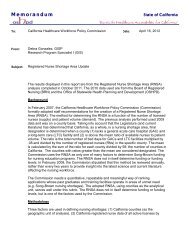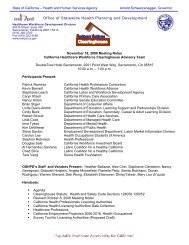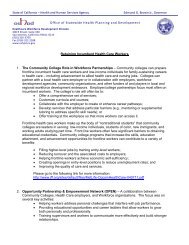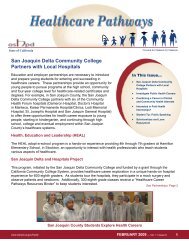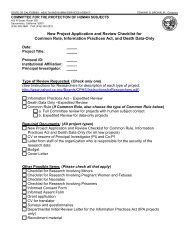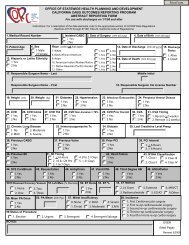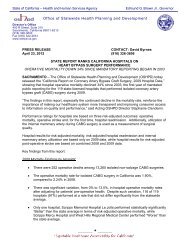Best Practices for Project Management, Design, and Construction of ...
Best Practices for Project Management, Design, and Construction of ...
Best Practices for Project Management, Design, and Construction of ...
You also want an ePaper? Increase the reach of your titles
YUMPU automatically turns print PDFs into web optimized ePapers that Google loves.
<strong>Project</strong> Selection <strong>and</strong> Identification Phase<br />
<strong>Best</strong> Practice 1: Underst<strong>and</strong> <strong>and</strong> communicate clearly what you want to accomplish<br />
Whether the project is as simple as introducing a new piece <strong>of</strong> equipment into your facility or as<br />
complicated as replacing an entire acute care campus, all subsequent strategies <strong>for</strong> working with<br />
OSHPD stem from how clearly <strong>and</strong> unambiguously you underst<strong>and</strong> what you want to accomplish.<br />
Develop an overall Master Facilities Plan <strong>and</strong> Program. Some hospitals are currently incurring<br />
additional expense in meeting the seismic m<strong>and</strong>ate because over the years construction <strong>and</strong><br />
renovation projects took place without a Master Facilities Plan. There<strong>for</strong>e, in meeting the seismic<br />
m<strong>and</strong>ate some seismic compliant buildings <strong>and</strong> systems need to be modified or replaced while<br />
conducting seismic retr<strong>of</strong>its <strong>of</strong> noncompliant buildings. A Master Facilities Plan can assist in<br />
predicting when a proposed project may trigger upgrades <strong>of</strong> mechanical, electrical, plumbing, <strong>and</strong><br />
structural systems as well as assist in determining where additional sources <strong>of</strong> power are<br />
required.<br />
To assist hospitals in interpreting clinic building code requirements OSHPD developed Code<br />
Application Notice (CAN) 1-7-2100. This CAN will assist hospitals in determining which building<br />
authority has responsibility <strong>for</strong> a clinic project <strong>and</strong> to what code it is designed <strong>and</strong> reviewed.<br />
OSHPD reports that some local jurisdictions <strong>and</strong> clinic owners <strong>and</strong> design pr<strong>of</strong>essionals have<br />
experienced confusion regarding which clinics <strong>and</strong> outpatient facilities are subject to the clinic<br />
requirements (OSHPD 3) found in the Cali<strong>for</strong>nia Building St<strong>and</strong>ards Code (CBSC). This results in<br />
a lack <strong>of</strong> consistency in application <strong>of</strong> the model code <strong>and</strong> OSHPD 3 requirements to clinic<br />
facilities as well as uncertainty regarding the roles <strong>of</strong> the local building department <strong>and</strong> OSHPD in<br />
the plan review, certification, <strong>and</strong> construction inspection processes.<br />
Also, the hospital seismic m<strong>and</strong>ate provides compliance options <strong>for</strong> noncon<strong>for</strong>ming buildings.<br />
Such buildings shall (a) be retr<strong>of</strong>itted; (b) be closed, demolished, or replaced; or (c) have their<br />
acute care services removed <strong>and</strong> be converted to non-acute-care use. Over the next few years, a<br />
number <strong>of</strong> all hospital buildings could be converted from general acute care hospitals to other<br />
uses. There<strong>for</strong>e, OSHPD issued CAN 2-3406A, which clarifies the CBSC <strong>for</strong> a Change <strong>of</strong><br />
Occupancy.<br />
<strong>Best</strong> Practice 2: Be realistic about the preliminary budget <strong>and</strong> length <strong>of</strong> time needed to<br />
achieve your goal<br />
Be prepared to invest the necessary time <strong>and</strong> resources. Determine if an integrated project team<br />
is needed <strong>for</strong> the project. It may result in higher front-end costs but more reliable overall project<br />
costs. <strong>Project</strong> cost estimates must take into consideration needed equipment, inflation, the project<br />
design, plan review schedule, <strong>and</strong> construction time. Being realistic will minimize delays that arise<br />
when plans are in OSHPD review. Develop <strong>and</strong> validate current project concept budgets, with<br />
(OSHPD <strong>Best</strong> <strong>Practices</strong>) Page 88 DRAFT FINAL, Sept. 2011



